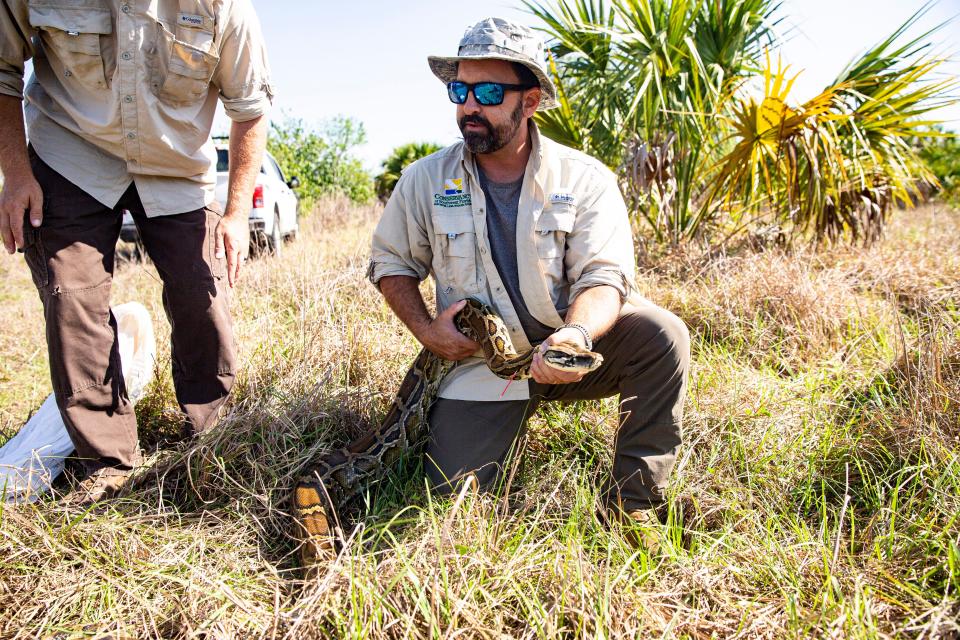Some Florida pythons may actually be a mix of multiple snake species, report says
Burmese pythons have been wreaking havoc on South Florida's ecosystems for decades, and reports from the state suggests these massive constrictors have eaten nearly every fur-bearing animal in the Everglades.
But they may not have done it alone as scientists discovered that a small percentage of the snakes here also have Indian python genetics, meaning the snakes in South Florida are practically a breed of their own.
Burmese pythons (Python bivittatus) grow to 20 feet in length and 200 pounds, and they basically eat every animal in South Florida.
Indian pythons (Python molurus) are larger than native Florida snakes and typically reach 10 feet in length and weigh nearly 30 pounds.
Both snakes are native to Asia ― the Burmese found more in Eastern Asia and the Indian snake, well, being found mostly in India.
They're both solitary ambush hunters that are accustomed to semi-tropical habitats like South Florida.
Invasive animals often have advantages over native wildlife as they typically don't have predators. Sure, many animals will eat a 4-foot python, but a 12-footer is basically free to roam the wilds without being attacked.
But when you combine the genetics of two closely related species, the result can be an animal that's capable of quickly adapting to a foreign environment.

That may be what happened with the pythons found in Florida, according to a United States Geological Survey report released earlier this year.
Dealing with invasive animals and plants across the United States costs billions annually, and Florida is home to droves of non-native species.
A super snake?
Some media have dubbed the mixture as a "super snake," but Ian Bartoszek, a biologist and python expert at the Conservancy of Southwest Florida, said the much of the mixing likely happened before the snakes were released.
He doesn't agree with the super snake portrayal, saying instead that the snakes have adapted to Florida's ecosystems but that there's nothing super about them.
"It's likely a mix of the two from the pet trade," Bartoszek said. "Whether that conveys abilities to them is unknown."
Records shows that about 100,000 Burmese pythons were imported to the United States since the late 1970s, Bartoszek said, primarily from Vietnam and Thailand.
"Who knows what happened in the pet trade here," he said.
Burmese pythons may be a perfect fit for Florida
Bartoszek said he's more concerned about the adaptation of the wild snakes here, that they may have certain traits that make them more fit for Florida.
"The way we like to look at it is: Are they adapting to the Everglades?" he said. "I think now that they're here in the wild there are selection events that are flipping the switches in those species."
One fear has been that the Burmese python (or whatever it is) will spread north into other parts of Florida and, perhaps, beyond.
The adaptations they're undergoing and have undergone in the wild will determine just how well they will be able to tolerate colder temperatures.
"Some are better at hiding and getting down in burrows and can wait out cold events, they're adapting to South Florida's habitats and the burrows may afford them some level of protection," Bartoszek said.
Filling Florida's niche
Relative to areas like South America's Amazon, Florida is a young area, ecologically. The longer an ecosystem has been active, the more likely various ecological niches will be filled.
"Some niches here are available because the Everglades has the ability to support them, for that animal to plug-and-play if you will," he said. "There are still some areas that are open (for invasion), and the Burmese python happened to be a perfect fit."
Connect with this reporter: Chad Gillis on Facebook.
This article originally appeared on Fort Myers News-Press: Some Florida pythons may be mix of Burmese, Indian snakes, report says

